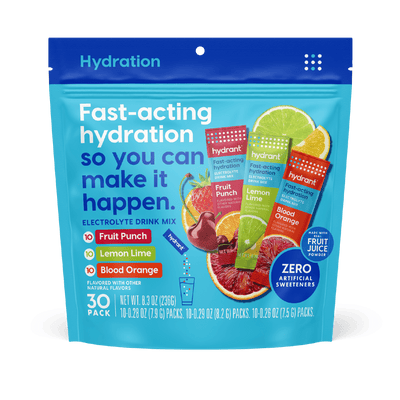If you’ve spent any amount of time researching the keto diet, there’s a good chance you’ve come across the term “keto flu.” At first, it sounds pretty intimidating, right? Who wants to follow a diet that has a type of flu named after it?
The good news is that the keto flu can be a pretty short-lived experience, and may not distract from your personal wellness decision of switching to a keto diet. To further sweeten the deal, there are also plenty of steps you can take to potentially help minimize the symptoms of the keto flu.
Outlined below is everything you need to know about the keto flu, from what it looks and feels like, to some generalized wellness recommendations pulled together to help lessen its effects.
What Is Keto Flu?
Let’s start with the basics. What is the keto flu, really?
For starters, the “keto flu” is not an actual illness. It’s not the same thing as influenza or stomach flu. It’s just a name that refers to a collection of symptoms some people might experience when they start following a keto diet.

The keto flu is also referred to as the low carb flu or the carb flu.
Keto Flu Symptoms
Everyone’s experience with the transition from being fueled by carbohydrates to being fueled by fat is different. In general, though, the following symptoms have been associated with the body shifting into ketosis (a fat-burning state) like when following the keto diet [1]:
- Nausea and vomiting
- Stomach cramps
- Diarrhea or constipation
- Headaches
- Irritability and/or mood swings
- Muscle cramps, weakness, or soreness
- Dizziness
- Difficulty concentrating
- Changes in sleep quality/quantity
- Cravings for sugar and carbohydrates
The severity of keto flu symptoms varies from person to person, and there is not a one-size-fits-all experience. There are lots of factors that influence how intense symptoms can be, including the following:
- The number of grams of carbohydrates consumed per day prior to starting the diet
- A person’s hydration level
- A person’s stress level
- The number of hours slept per night
- The quality of food consumed
What Causes Keto Flu?
There are a few reasons why keto flu symptoms occur. The following are some of the most well-known:
Reduced Water and Electrolytes
As you transition into a state of ketosis, your body loses water and important electrolytes (especially sodium).
One reason why this happens is the fact that glycogen (the body’s stored form of sugar) is stored with water (about 3 grams’ worth) [2]. When your body burns up all of its stored carbohydrates, this water gets excreted and you can end up dehydrated.
Decreased Thyroid Hormone
Transitioning to ketosis can affect your thyroid hormone levels (specifically, levels of the hormone T3) as well [3]. When T3 decreases, you might start to experience certain (usually temporary) symptoms linked to the keto flu, including fatigue and trouble concentrating.
Increased Stress Hormones
When you first start restricting carbohydrates and your body burns through its glycogen stores, your levels of cortisol (a stress hormone) may increase in the short-term [4]. Increases in stress (and stress hormones) can lead to temporary symptoms like headaches, digestive issues, and other keto flu symptoms.
When Does Keto Flu Hit?
Most people experience these symptoms shortly after they begin following the keto diet. When you initially switch from eating a high- or moderate-carbohydrate diet to eating one that’s low in carbs, your body may be thrown off by the change in fuel sources, and it can take a moment for it to readjust and adapt.
How Long Does Keto Flu Last?
On average, keto flu symptoms last about one week. Some people might notice that their symptoms last a bit longer than this, though. This is especially true for those who were eating a very high-carbohydrate diet or those who are poorly hydrated.
How to Manage Keto Flu Symptoms
You can also reduce the longevity and severity of your keto flu symptoms. Below are some compiled recommendations that can help with transitioning from a carb-burning state to a fat-burning one. Just like there’s no one-size-fits-all experience for symptoms, these recommendations are here to serve as tools in your general wellness plan.
Stay Hydrated
One great tool to have in your back pocket to help with your wellness goals and tackle some of the symptoms of the keto flu is hydration.
When switching from burning carbs to burning fat, your body may lose a lot of water, and replacing those lost fluids can help you stay ahead of dehydration.

But, it may not be enough to drink water alone. You also need to make sure you’re replacing the electrolytes your body could be losing. A lack of electrolytes, even in the presence of sufficient water, may not be enough to sufficiently hydrate you in a timely manner.
Consider using pre-packaged hydration mixes (keep an eye out for those with no added sugar) for easy electrolyte replacement. Another recommendation is to add additional salt to your food, too, for an easy sodium boost.
Engage in Gentle Exercise
Another recommended approach is to focus on non-high-intensity exercise (running, HIIT workouts, CrossFit workouts, etc.) when transitioning to a keto diet for the first time. As one common symptom can be general fatigue, higher-intensity workouts make leave you more energy deficient.
Instead, gentle exercise or active recovery days may be helpful to keep symptoms at bay or supplement your wellness plan during the transition period. As your body relearns how to fuel itself, you may be able to slowly add back more intense workouts into your plan. Like any of these recommendations, listen to your body and your own wellness needs above all [5].
Get Plenty of Sleep
You may feel more fatigued than usual while transitioning into and getting used to ketosis. One recommendation is to lean into this and use the time to set intentional rest periods and catch up on quality sleep.

Implementing some healthy practices that will support quality sleep during this time can be helpful. Minimizing your afternoon caffeine intake, and exposing yourself to plenty of natural light during the daytime (this is good for your body’s ability to regulate sleep and wakefulness), are all great starting points [6].
Increase Your Fat Intake
Make sure you’re not just eating fewer carbs during this period. Increase your fat intake to make up for a reduction in carbohydrates, too.
Lots of people make the mistake of cutting carbs but not replacing them with a sufficient amount of fat. This, in turn, leads to worse keto flu symptoms since you’re not just eating a low-carb diet, but also a low-calorie diet.
Bump up your fat intake while you transition into ketosis. There are lots of macronutrient calculators that you can use to figure out approximately how many grams of fat you should be aiming for per day while on this diet.
Practice Mindfulness
Another way that you can reduce your stress is to add some mindfulness practices into your routine.
Practices like meditating, yoga, or walking outside (without your phone or other distractions) can help to lower cortisol levels [7]. They can also make symptoms like headaches, stomach pain, and difficulty concentrating more manageable [8].
Some people might be intimidated by the idea of practicing mindfulness at first, but it doesn’t have to be scary. There are lots of apps that can guide you as you begin your journey. You can find free videos on YouTube and Instagram, too.
Wellness Plan for the Keto Diet
In the period of transition to a keto diet, you may experience the keto flu or other symptoms in transition. Think about some wellness strategies you can implement to set yourself up for success. A couple of things to keep in mind:
Ease Into It
Start slow and listen to your body. By gradually decreasing your carbohydrates, you can make the transition process easier and help your body to adapt more easily.
Time It Right
Think through the timing of when you want to start this transition, and when you can prioritize your wellness goals. Scheduling a transition to the keto diet may not be a great idea when there’s a big deadline at work, or stress levels are high.
Plan Your Meals and Snacks
Thinking ahead about meal planning, finding recipes upfront, and prepping ahead of time can be a great time saver and ease meal-time stress.
Above all, remember that you know your body best. Hopefully these recommendations will be great starting points to build out a comprehensive wellness plan as you start your journey on the keto diet.


















